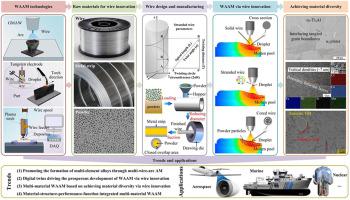International Journal of Machine Tools and Manufacture ( IF 14.0 ) Pub Date : 2023-11-28 , DOI: 10.1016/j.ijmachtools.2023.104103 Hao Yi , Le Jia , Jialuo Ding , Huijun Li

|
Multi-material components featuring high performance and design flexibility have attracted considerable attention, providing solutions to meet the performance demands of high-end equipment components. Achieving material diversity in additive manufacturing (AM) is a fundamental step towards manufacturing multi-material components. Wire arc additive manufacturing (WAAM), an important branch of AM technology, boasts notable advantages in the efficient and customized preparation of large-scale parts due to its high deposition efficiency and unrestricted forming size. However, achieving material diversity in WAAM, constrained by its reliance on wire-form raw materials, has emerged as a compelling challenge. Wire innovation, including multiple, stranded, and cored wires, have furnished solutions to this challenge. To this end, this review provides an overview of the current developments in WAAM via wire innovation and suggests future research directions, aiming to serve as a reference for the further advancement of WAAM. Initially, the article introduces several WAAM printing forms, their manufacturing features, printable materials and inherent manufacturing limitations, and the intermixing of metal constituents of WAAM, prior to highlighting the advantages and necessity of achieving material diversity. Subsequently, the exposition of multi-wire-arc AM demonstrates its utility in the preparation of binary or ternary alloys, inclusive of intermetallic compounds and functionally graded materials, responding adeptly to the deficiencies of conventional WAAM, which is limited to single-material printing. The merits and progression of stranded-wire-arc AM for high-entropy alloy production are synthesized and debated, especially given that creating components with multiple metal elements via multi-wire-arc AM customarily confronts the constraint of necessitating more intricate manufacturing equipment and processes. Further, the review explores the recently developed cored-wire-arc AM technology, which actualizes the manufacturing of composite materials, amalgamating metals and non-metals, to remedy the issues encountered with standard WAAM, incapable of realizing non-metallic material printing. Considering machine tools as an important means to achieve material diversity in WAAM, we expand on the current machine tool architecture and its corresponding design tools. Finally, the current research status on WAAM via wire innovation is summarized and potential future research directions are proposed.
中文翻译:

实现电弧增材制造的材料多样性:通过线材创新从合金跨越到复合材料
具有高性能和设计灵活性的多材料部件引起了广泛关注,为满足高端设备部件的性能需求提供了解决方案。在增材制造 (AM) 中实现材料多样性是制造多材料部件的基本步骤。电弧增材制造(WAAM)作为增材制造技术的重要分支,由于其沉积效率高、成形尺寸不受限制,在大型零件的高效定制制备方面具有显着优势。然而,由于 WAAM 对线状原材料的依赖,实现材料多样性已成为一项引人注目的挑战。电线创新,包括多股线、绞线和芯线,为这一挑战提供了解决方案。为此,本文通过线材创新概述了WAAM的当前发展,并提出了未来的研究方向,旨在为WAAM的进一步发展提供参考。首先,本文介绍了几种 WAAM 印刷形式、它们的制造特点、可印刷材料和固有的制造限制,以及 WAAM 金属成分的混合,然后强调了实现材料多样性的优势和必要性。随后,多线电弧增材制造展示了其在制备二元或三元合金(包括金属间化合物和功能梯度材料)方面的实用性,巧妙地解决了传统WAAM仅限于单一材料打印的缺陷。对用于高熵合金生产的绞线电弧增材制造的优点和进展进行了综合和讨论,特别是考虑到通过多线电弧增材制造制造具有多种金属元素的部件通常面临需要更复杂的制造设备和工艺的限制。此外,该综述还探讨了最近开发的包芯线电弧增材制造技术,该技术实现了复合材料的制造,将金属和非金属融合在一起,以解决标准WAAM无法实现非金属材料打印的问题。考虑到机床是实现 WAAM 材料多样性的重要手段,我们扩展了当前的机床架构及其相应的设计工具。最后,总结了目前基于线材的WAAM创新研究现状,并提出了未来潜在的研究方向。












































 京公网安备 11010802027423号
京公网安备 11010802027423号